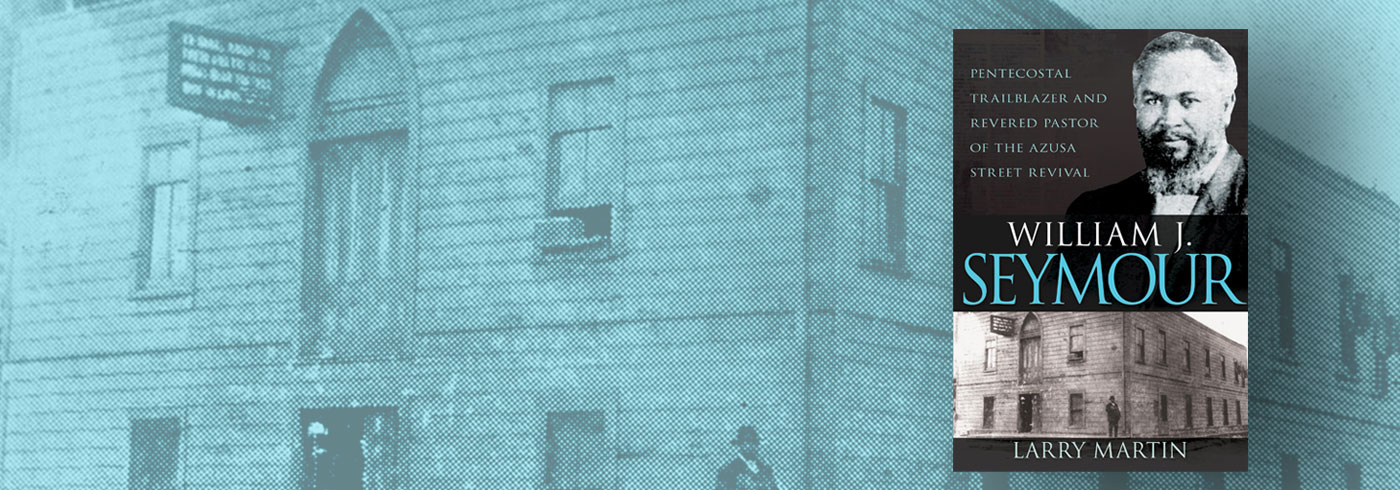Simple Obedience, Profound Influence, Humble Leadership
Review of “William J. Seymour” by Larry Martin
The Pentecostal story is one of unlikely heroes. Our story is more about ordinary people who do extraordinary things through the power of the Spirit than the exploits of the powerful and elite.
No one exemplifies this more than Pastor William J. Seymour, the founder of the Azusa Street Mission and Revival. His story is one of simple obedience, profound influence, and humble leadership amidst profound obstacles against him.
In 1999, Larry Martin was one of the first to tell Seymour’s story in a full biography called The Life and Ministry of William Seymour. Martin is well known for his desire to bring the details of Pentecostal history to life through his relentless archival research. That book introduced many in our movement to the humble leader whose small mission became the center of a global revival.
Twenty-five years later, Martin re-released his Seymour biography with Whitaker House, which contains updated research and new insights into Seymour’s life and ministry.
The quality of historical research in Martin’s work is remarkable. He skillfully unpacks the scant details of Seymour’s early life as one of 16 children born into a family of formerly enslaved Africans in Louisiana.
Next, Martin tracks Seymour as he journeys North as a young adult, where Martin uncovers Seymour’s early ministry in the African Methodist Episcopal Church in Indianapolis and his exposure to the Holiness movement in Cincinnati. Probing city directories, newspaper clippings, and archival collections, Martin pieces together a sketch of Seymour’s life that would no doubt be lost to history.
Complemented with copies of rare photographs, news clippings, and scans of documents, the historical work in this volume is truly breathtaking.
Martin’s biography not only gives details of Seymour’s life but also of the significant secondary actors in the Azusa Street Revival story. Alongside the details of Seymour’s journey, Martin uses his research skills to unearth historical details for important figures, including Lucy Farrow, Edward Lee, and Frank Bartleman. The historical details Martin adds about the people and events give the story depth.
Important to Seymour’s life is his complicated relationship with Charles Parham. Having also authored a biography of Parham (Whitaker House, 2022), Martin does not shy away from the issues of racism in Parham’s relationship with Seymour.
At the same time, Martin suggests this is a later development. For example, he provides evidence that challenges the often-repeated story that Seymour had to listen to Parham’s teachings through the window at the Houston Bible school because of Jim Crow laws. Martin also points out that Seymour was a partner in ministry with Parham. Seymour was considered to have great potential in helping Parham reach other Blacks in the South.
Seymour is of primary importance as the leader of the Azusa Street Revival. Several chapters are devoted to how the revival began and its impact on many of the movement's early leaders.
His story is one of simple obedience, profound influence, and humble leadership amidst profound obstacles against him.
However, as is in the book title, Martin emphasized Seymour as “Pastor of the Azusa Street Revival.” This is a significant contribution to the work. Seymour wasn’t just host to a revival; he was a faithful shepherd during the move of God. Seymour balanced the freedom of the Spirit with the responsibility for maintaining biblical order. While a humble man, he knew when to step in when someone was trying to detract from keeping Jesus at the center.
Every page of Martin’s portrayal reflects his respect for Seymour’s humble and spiritual leadership. Martin believes Seymour to be “one of the purest, saintliest, and humblest men who ever lived.” Pastor Seymour led three services daily for at least three years during the heart of the revival.
Martin points out that while American society was at the height of its cruelty to Black men, Seymour’s ministry made a difference in thousands of lives. His mission inspired and impacted the lives of nearly every Pentecostal denomination. Seymour provided space for where the love of God erased differences because of race and cultural norms. He passionately proclaimed the power of Pentecost to change people’s lives. The mission attracted people from around the world and empowered missionaries to travel across the globe with the gospel.
While Martin sees Parham as the “Father of the Pentecostal Movement,” there is no doubt that Seymour’s Azusa Mission was the catalyst that introduced the world to the message of Pentecost.
The story Martin tells of Seymour’s life in ministry is vital for Pentecostals in several ways. Seymour overcame poverty and lack of education in his childhood yet became a leader of thousands in the Kingdom. He also overcame a personal illness that caused blindness in one eye, yet Seymour had a vision of unity and diversity that few could see. He overcame racism in a society that would relegate him to the margins, yet Seymour impacted the world. I agree with Martin that Seymour is one of our movement’s most significant leaders.
The book’s last few chapters focus on the tragedy of the Seymour story. This is a part of the story many people do not know. For a brief few years, the Azusa Mission was heaven on earth. But by 1909, the vision faded as the realities of human ambition, racism, jealousy, and sinfulness worked to unravel the revival.
The local press derided Seymour with racist cartoons mocking the Pentecostal phenomenon that took place. White leaders tried multiple times to take over the leadership of the revival. Other white Pentecostal missions in Los Angeles competed for followers.
Seymour’s close friend, Clara Lum, suddenly left his ministry and stole the Apostolic Faith paper along with its mailing list, leaving Seymour without a publication. Parham’s jealousy of Seymour’s success led to several harsh and racist tirades about his leadership.
By 1910, Seymour struggled to keep the mission open, and his travels from that point were primarily in Black Pentecostal churches. The movement he catapulted to prominence all but forgot about him.
I am deeply grateful for Martin’s attention to the tragic side of Seymour’s story. It can be very easy to glorify the past and celebrate revivals as “heaven on earth.” But history tells us this was far from the case.
Yes, many miracles took place, but many injustices also happened. We cannot allow nostalgia to override the truth of the past. We must confront the reality that while Frank Bartleman may have observed that the “color line was washed away in the blood,” the issues of racism and white superiority were instrumental in its demise.
By God’s grace, Pentecostalism spread, and today is the fastest-growing segment of Christianity. But that is a testimony to God’s mercy, not a tribute to our forbearers’ spiritual integrity. The stories about the ugly side of the early Pentecostal movement are just as crucial for us to understand as the stories of the miracles. They teach us that behind the glory, there are human realities that must be guarded against.
If it can happen at Azusa Street, the most significant historical revival, then it can happen on Main Street today. We can’t fix the past, but we can work towards the vision Pastor Seymour gave the world.
Martin has given our movement a great gift in this book. His historical research and passion for revival are a perfect mix. Seymour’s story and the Azusa Street Revival story are inseparable. It is a story about a God who moves and the humble servant whom He uses. It is about tongues of fire and tongues used to denigrate. It is about miracles and mistakes. It is a story about God’s power and human frailty. Every generation deserves a Pentecost. We have a responsibility to tell this story.
“The stories of what happened in a dilapidated building on an unpaved street in Los Angeles will be told as long as new generations of Spirit-empowered believers have breath to retell them,” Martin concludes.
Book Reviewed
Larry Martin, William J. Seymour: Pentecostal Trailblazer and Revered Pastor of the Azusa Street Revival (New Kensington, PA: Whitaker House, 2024).
Influence Magazine & The Healthy Church Network
© 2025 Assemblies of God

